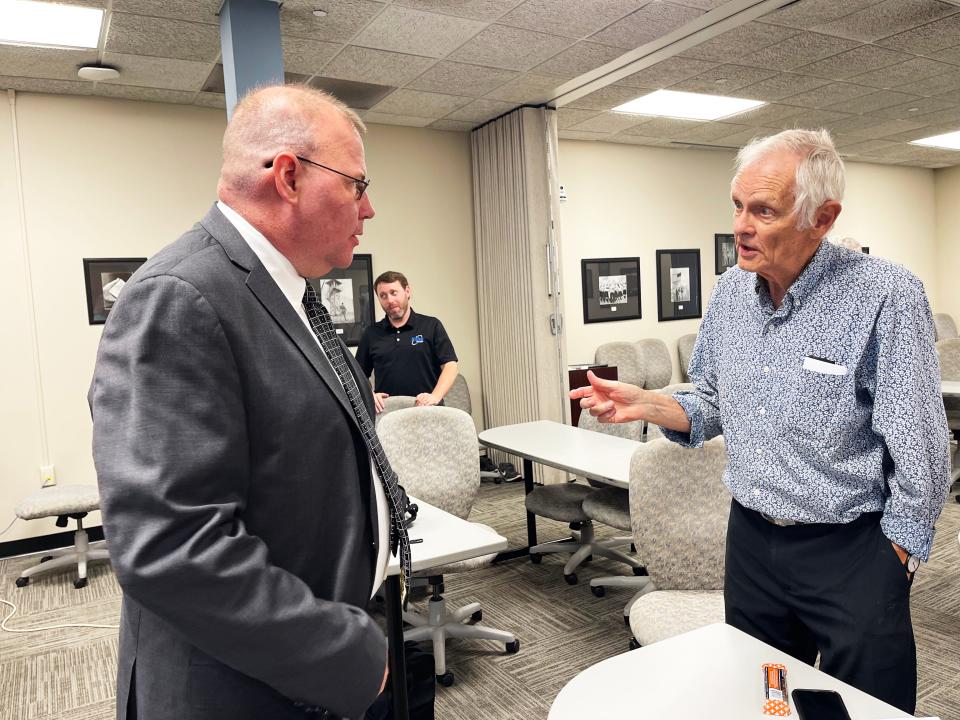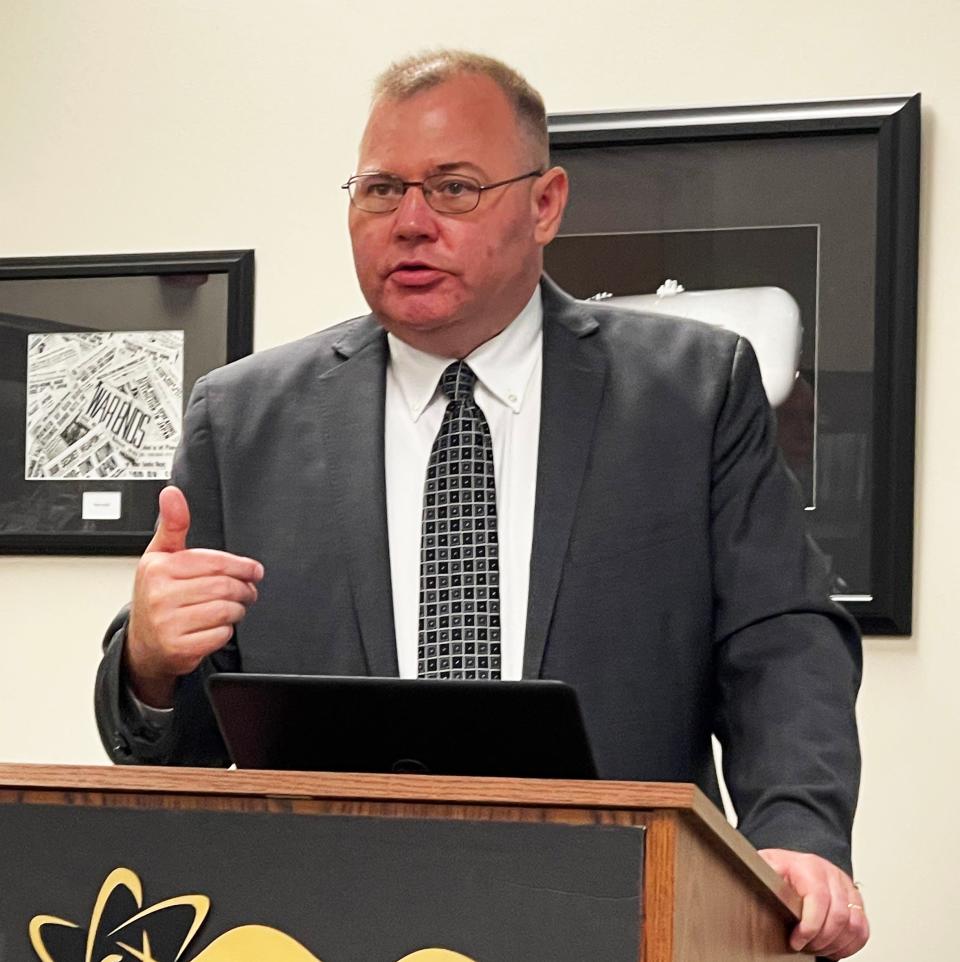ORNL molten salt concept could lead to 'smartphone' of reactors
- Oops!Something went wrong.Please try again later.
If Alvin Weinberg, the most renowned director of Oak Ridge National Laboratory, were alive today, he would likely agree with Kirk Sorensen, the founder of Flibe Energy Inc., that a molten salt reactor such as the one developed by ORNL teams in the 1950s and 1960s would lead to a more sustainable electricity source than the pressurized water reactor (PWR) that Weinberg co-invented in the 1940s.
PWRs, first used to propel submarines, are at the heart of two-thirds of the world’s nuclear power plants today.

Weinberg long promoted the ORNL-designed molten salt reactor experiment (MSRE) based on Glenn Seaborg’s 1942 discovery using a cyclotron that bombarding thorium with neutrons that eventually yields uranium-233, a potential fuel for a nuclear reactor. Because U-233 undergoes fission, producing heat and neutrons, it can be harnessed to make electricity and convert thorium in the blanket region of a reactor to protactinium, which can be drawn into a tank where it decays in about a month into U-233. This product can refuel the reactor from which its precursor came.
In a talk to Friends of ORNL, Sorensen noted that thorium, which can be found all over the world in soil and rocks, is a more sustainable source of nuclear fuel than the uranium which has been largely mined from the Colorado Plateau, on tribal lands where Native Americans are still recovering from the harmful health and environmental impacts of “uranium mining operations in the first era of nuclear expansion.”
He added that “if reduced to metal, in an average cubic meter of dirt, anywhere in the world, there are about two sugar cube volumes of thorium and one-half a sugar-cube volume of uranium. And there is more energy in this small amount of thorium than in an equivalent cubic meter of the finest anthracite coal or crude oil.”
Sorensen compared the large PWRs of the 1970s to the landline telephone, the small modular reactors (SMRs) based on light-water reactors to the flip cellphone, and the new designs of liquid salt reactors based on the ORNL concept to the smartphone. He explained that PWRs and SMRs mainly will produce electricity, just as the landline and flip phones chiefly function as telephones.
Like the smartphone, which does so much more than make phone calls, Sorensen said that the lithium-fluoride thorium reactor (LFTR) his private Alabama company has designed and is proposing to build will be more than a power source. It will provide a constant flow of medical isotopes. It can destroy high-level nuclear wastes. It can generate large amounts of heat for teasing hydrogen from water.
Hot molten salts from the LFTR could provide heat at a temperature of 650 degrees Celsius to drive supercritical carbon dioxide through a small turbine to make electricity at an efficiency of 45%.
Some of the created U-233 (like that stored at ORNL, which he called “the goose laying golden eggs”) can be allowed to decay into actinium-225, which is transported to medical centers where it decays to bismuth-213, an emitter of alpha particles; using an ORNL invention, such targeted alpha therapy is currently used for treating brain and other tumors, bladder cancer and leukemia.
The company’s goal, he said, is to build LFTR power plants between 2030 and 2035 to supply municipalities with 20-30 megawatts of electricity.
Since 2006, Sorensen has been a public proponent of thorium reactor technology, giving numerous talks across Europe and North America, as well as in Asia and Australia. After founding Flibe Energy in Huntsville, Alabama in 2011, he led the company’s efforts in developing the LFTR and carrying out an industry-funded conceptual study for the Electric Power Research Institute. He has spoken at molten-salt-reactor workshops at ORNL.
In his talk, Sorensen argued that the LFTR and other liquid salt reactors, rather than the traditional and modular light-water reactors (including PWRs), are the key to an affordable, sustainable energy future. He gave these comparisons.
PWRs use water under pressure to cool the solid uranium fuel and carry its energy to heat exchangers to heat a working fluid to make steam to drive a turbine to produce power. The LFTR will use a liquid salt consisting of fluorine, lithium and beryllium (that’s why Sorensen’s company is called FLiBe – these elements’ symbols). The salt, which consists of lithium fluoride and beryllium fluoride (LiF and BeF2), has two purposes.

First, the salt will serve as a coolant that carries the reactor’s heat to the working fluid. Second, the salt will contain the nuclear fuel, which is uranium-233 in the form of uranium tetrafluoride. The reactor will also have a blanket of liquid salt that contains thorium tetrafluoride. It will absorb many of the reactor’s neutrons (slowed down by a graphite moderator) and eventually the contents will decay outside the reactor core into U-233 nuclear fuel.
Because the LFTR fuel is already in liquid form, the notion of a reactor meltdown is meaningless in this design as a safety risk. According to the flibe.com website, “Any increase in operating temperature reduces the density of the liquid salt which in turn, causes the reaction to slow and the temperature to fall. The LFTR is also designed with a simple frozen salt plug in the bottom of the reactor core vessel. In the event of power loss to the reactor, the frozen salt plug quickly melts, and the fuel salt drains down into a storage tank below – causing a termination in the fission process.”
The LFTR, Sorensen noted, operates at a high temperature but ambient pressure; as a result, unlike the PWR, which runs at high pressure, a large, thick, reactor pressure vessel and other high-pressure infrastructure are not required. As a result, the LFTR could be built on assembly lines such as those used in shipbuilding, reducing its overall cost.
Because uranium enrichment is required to provide fuel for light-water reactors, Sorensen said, there is a risk that enriched nuclear fuel can be diverted from the process for weapons purposes.

"No one has ever made an operational nuclear weapon from uranium-233,” he added.
The problems involved with nuclear waste management are cited as a major objection to expanding nuclear power to replace fossil fuel sources of electricity and thus reduce carbon dioxide emissions. Nuclear wastes from PWRs include highly radioactive, long-lived transuranic wastes that require permanent geologic disposal, but would not be produced in LFTRs, Sorensen said.
According to the flibe.com website, “LFTRs will produce far less waste than current reactors along the entire fuel cycle and process chain, from ore extraction to nuclear waste storage. Lithium reactor technology can also be used to consume the remaining fissile material available in spent nuclear fuel stockpiles around the world and to extract and resell many of the valuable fission products that are currently considered waste.”
In his FORNL talk, Sorensen implied that he and Weinberg would agree on another point: the U.S. government has provided a mix of support for and resistance to efforts to perfect an invention that promises to meet world energy needs with a clean, reliable, passively safe and scalable source of electricity, as well as offering other benefits.
This article originally appeared on Oakridger: ORNL molten salt concept could lead to 'smartphone' of reactors

